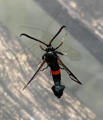2021 Annual Report for: Sesiidae / Sesiinae
For species seen in 2021 that had less than or equal to 100 records, full details are included; for more common species, the earliest, latest and highest count by vice-county are shown. The narrative for each species is taken from the main Hantsmoths website, and it is possible that some information on abundance and occurrence can get out of date, as it is impossible to keep up with all changes; however it should give a good introduction to each species. The tables in each species account summarise the previous status, and that for the current year.
For the maps, all records prior to 2021 are shown by a blue dot (the larger the dot, the more recent), with the current year's records shown in red. As previous records are superimposed on any report for 2021, new sites have greater emphasis (i.e. will show as 'more red').
In the species accounts, an asterisk next to a location indicates a new 10km square record; earliest ever dates are highlighted in orange, and latest ever in red. Initials in the species accounts refer to the recorders listed here. Please get in touch if you identify any omissions or errors, in particular if you have records that have yet to be submitted. Details of how to submit records can be found here.
52.003 [B&F: 0371] Lunar Hornet Moth Sesia bembeciformis (Hübner, [1806]) - Common
Common in fens, woodland, heaths, moorland and hedgerows throughout much of the British Isles, with most records in central and southern England. In Hampshire fairly well distributed, but apparently rare in the central half of northern Hampshire and the eastern quarter of southern Hampshire; also sparsely distributed on the Isle of Wight. Wingspan 32-42 mm. Day-flying. Mainly recorded in the larval form, but the early stages are not easy to find during the winter months; attempts to synthesise an artificial pheromone have so far proved only partially successful. Larva feeds within wood of Sallow, Poplar and Willow, over-wintering twice.
Records prior to 2021
| Vice County | #Records | #Individuals | First Record | Last Record |
|---|---|---|---|---|
| 10 | 11 | 7 | 1900 | 2020 |
| 11 | 85 | 53 | 1960 | 2020 |
| 12 | 33 | 12 | 1951 | 2020 |
2021 records
| Vice County | #Records | #Individuals | Max Quantity |
|---|---|---|---|
| 11 | 13 | 36 | 15 |
| 12 | 1 | 1 | 1 |
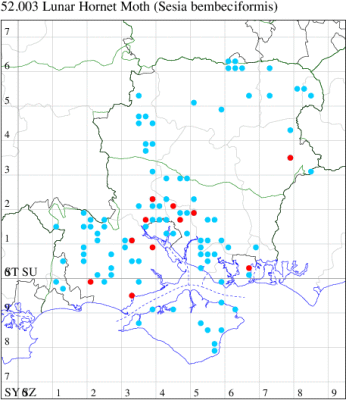
Records by year
Records by week (adult)
Records by week (larval)
Record Details
VC11: Marchwood, two, to pheromone lure, 12 Jul (CTha); Woodlands, NF, present, to pheromone lure, 20 Jul (RBW); Lee, nr Nursling, one, to pheromone lure, 18 Jul (CTha); Romsey, one, to pheromone lure, came to HOR lure in morning, 17 Jul; two, to pheromone lure, 18 Jul; five, to pheromone lure, 21 Jul (NRJ); Itchen Valley CP, 15, to pheromone lure, 16 Jul (CTha); Allbrook, one, to pheromone lure, lUN Lure @ 1035hrs, 17 Jul; Fair Oak, five, to pheromone lure, lUN Lure 1015-1100hrs, 14 Jul (SIng); Copnor, Portsmouth, one, to pheromone lure, 17 Jul (DAS); Stony Moors, Holmsley, one, field observation, 08 Jul; one, field observation, 14 Jul; Lymington, one, field observation, 15 Jul (PDB);
VC12: Whitehill*, one, to pheromone lure, 24 Jun (ASto)
52.006 [B&F: 0375] White-barred Clearwing Synanthedon spheciformis ([Denis & Schiffermüller], 1775) - Nationally Scarce
Nationally scarce (Nb) in heathland, marshes, river-banks and damp woodland in southern and central England, northwards to Yorkshire, and north and south Wales. In Hampshire mostly restricted to the extreme north and east of vice-county 12 (north Hampshire), while in vice-county 11 (south Hampshire) the species is recorded from Emer Bog and Chandler's Ford. Not recorded from the Isle of Wight to date. Wingspan 26-31 mm. Day-flying. The early stages may be sought during the winter months, but synthetic pheromone lures are used to attract males nowadays, and this has led to a marked increase in records of the species in recent years. Larva feeds within wood of Alder, Silver Birch and Downy Birch, over-wintering two or three times.
Records prior to 2021
| Vice County | #Records | #Individuals | First Record | Last Record |
|---|---|---|---|---|
| 11 | 8 | 5 | 1800 | 1994 |
| 12 | 50 | 93 | 1800 | 2020 |
2021 records
| Vice County | #Records | #Individuals | Max Quantity |
|---|---|---|---|
| 11 | 1 | 1 | 1 |
| 12 | 4 | 11 | 6 |
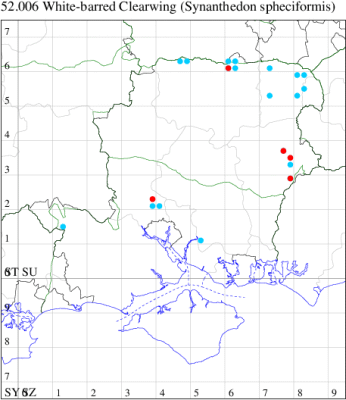
Records by year
Records by week (adult)
Records by week (larval)
Record Details
VC11: Romsey, one, to pheromone lure, came to TIP lure in afternoon, 03 Jun (NRJ);
VC12: Pamber Forest, one, to pheromone lure, 31 May; Longmoor Camp, Greatham, six, to pheromone lure, within a minute to the lure, 02 Jun (GJD); Shortheath Common, two, to pheromone lure, 10 Jun (ASD); Whitehill, two, to pheromone lure, 07 Jun (ASto)
52.007 [B&F: 0381] Large Red-belted Clearwing Synanthedon culiciformis (Linnaeus, 1758) - Nationally Scarce
Nationally scarce (Nb) in heaths and open woodland in parts of the British Isles. In Hampshire locally common in the north-east and around the New Forest. Not recorded from the Isle of Wight to date. Wingspan 22-25 mm. Day-flying, the earliest clearwing to emerge in spring. Generally larger than the similar Red-belted Clearwing, the sizes overlap and it can be distinguished by the orange-red suffusion at the base of the forewings and reddish palps. The larva feeds within bark of Silver Birch, Downy Birch and Alder, making characteristic tunnels under the bark of birch trees and stumps.
Records prior to 2021
| Vice County | #Records | #Individuals | First Record | Last Record |
|---|---|---|---|---|
| 11 | 23 | 24 | 1951 | 2020 |
| 12 | 42 | 159 | 1951 | 2018 |
2021 records
| Vice County | #Records | #Individuals | Max Quantity |
|---|---|---|---|
| 12 | 1 | 1 | 1 |
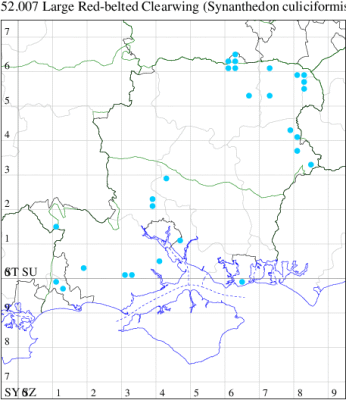
Records by year
Records by week (adult)
Records by week (larval)
Record Details
VC12: #N/A
52.008 [B&F: 0380] Red-tipped Clearwing Synanthedon formicaeformis (Esper, 1782) - Nb
Nationally scarce (Nb) in fens, marshes, river-banks, damp areas, gravel pits and ponds in southern England, northwards to Dumfriesshire, and southern Wales; rare in Ireland. In Hampshire found in small numbers in suitable habitat in both the north and south of the county, and probably under-recorded; the same is true of the Isle of Wight, where it was first found in 2015 but has been annual since. Wingspan 17-19 mm. Day-flying. The early stages may be sought during the winter months, but synthetic pheromone lures are used to attract males nowadays, and this has led to a marked increase in records of the species in recent years. Larva feeds within stems and wood of Osier, Willow and Sallow.
Records prior to 2021
| Vice County | #Records | #Individuals | First Record | Last Record |
|---|---|---|---|---|
| 10 | 13 | 65 | 2015 | 2020 |
| 11 | 52 | 81 | 1978 | 2020 |
| 12 | 25 | 45 | 2004 | 2020 |
2021 records
| Vice County | #Records | #Individuals | Max Quantity |
|---|---|---|---|
| 10 | 2 | 8 | 7 |
| 11 | 16 | 19 | 3 |
| 12 | 3 | 4 | 2 |
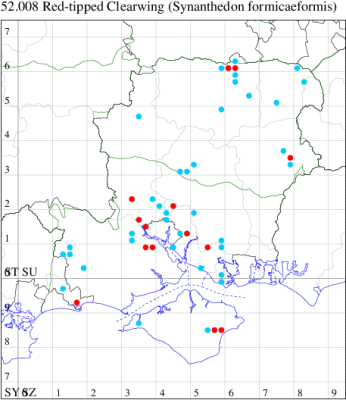
Records by year
Records by week (adult)
Records by week (larval)
Record Details
VC10: #N/ASandown, one, to pheromone lure, one moth responded to FOR lure two minutes after deployment, 05 Jul (IOut);
VC11: Marchwood, one, found dead, 20 Jul; one, by day, 03 Aug (TDCh); present, to pheromone lure, to Tip lure, 11 Jun; one, to pheromone lure, 25 Jun (CTha); Nursling Old Gravel Pit, one, field observation, 29 Jun; Nursling Substation, one, field observation, 06 Jul (JClx); #N/Atwo, to pheromone lure, fOR, 23 Jul; two, to pheromone lure, fOR, 03 Aug (JRM); Wildern LNR, one, field observation, 29 May; Wildern LNR, Hedge End, one, field observation, 26 Jun; one, field observation, 26 Jun (TCrw); Allbrook, one, to pheromone lure, 17 Jul (SIng); Funtley Meadow, one, to pheromone lure, tIP lure, 15 Jun (TDC); Botley Wood*, three, to pheromone lure, 23 Jun (DWal); Purewell Meadows BoC, one, to pheromone lure, 13 Jun (MGibb);
VC12: Pamber Forest, two, to pheromone lure, to FOR lure, 13 Jul; Lower Inhams Copse Meadow, Pamber, one, to pheromone lure, 01 Jul (GJD); Whitehill, one, to pheromone lure, 14 Jun (ASto)
52.010 [B&F: 0378] Orange-tailed Clearwing Synanthedon andrenaeformis (Laspeyres, 1801) - Nb
Nationally scarce (Nb) in chalk downland, limestone grassland and woodland edges in southern England, northwards to Worcestershire. In Hampshire probably found across the central chalk downs, but also found to the north in woodland and urban areas, including around Basingstoke. Surprisingly rare in South Hampshire south of Winchester. Not recorded from the Isle of Wight to date. Wingspan 18-22 mm. Day-flying. The early stages may be sought during the winter months, but synthetic pheromone lures are used to attract males nowadays, and this has led to a marked increase in records of the species in recent years. Larva feeds in the stems and twigs of Wayfaring Tree and less often in Guelder Rose, over-wintering twice. Old galls are conspicuous, but tenanted ones are difficult to see.
Records prior to 2021
| Vice County | #Records | #Individuals | First Record | Last Record |
|---|---|---|---|---|
| 11 | 62 | 67 | 1700 | 2020 |
| 12 | 131 | 303 | 1800 | 2020 |
2021 records
| Vice County | #Records | #Individuals | Max Quantity |
|---|---|---|---|
| 11 | 15 | 31 | 10 |
| 12 | 6 | 9 | 4 |
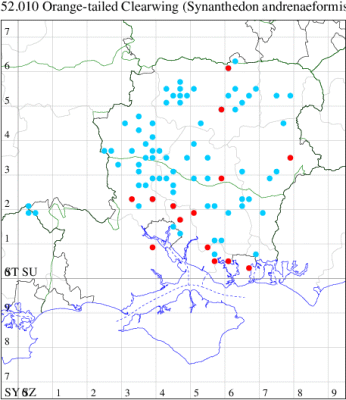
Records by year
Records by week (adult)
Records by week (larval)
Record Details
VC11: Marchwood, four, to pheromone lure, to VES lure, 20 Jun; two, to pheromone lure, 25 Jun (CTha); Romsey, 10, to pheromone lure, 02 Jul (NRJ); #N/Aone, to pheromone lure, vES, 02 Jul; one, to pheromone lure, vES, 03 Jul; two, to pheromone lure, vES, 09 Jul; one, to pheromone lure, vES, 23 Jul (JRM); Itchen Valley CP, two, to pheromone lure, 16 Jul (CTha); Allbrook, one, to pheromone lure, vES lure, 12 Jun (SIng); Funtley Meadow, one, to pheromone lure, vES lure, 15 Jun (TDC); Fareham, one, to pheromone lure, 01 Jul (ADT); Fair Oak, one, to pheromone lure, vES lure, 23 Jun (SIng); Portchester, one, to pheromone lure, 16 Jun; Copnor, Portsmouth, one, to pheromone lure, 17 Jul (DAS);
VC12: Hinton Ampner, one, to pheromone lure, 28 Jun (ASD); Basingstoke, one, to pheromone lure, to MYO lure, 1145hrs, 16 Jun; Kempshott, four, to pheromone lure, to VES between 1400 and 1530, 14 Jul; one, to pheromone lure, to VES at 1615, 17 Jul (GAH); Pamber Forest, one, to pheromone lure, 16 Jun (GJD); Whitehill, one, to pheromone lure, 17 Jul (ASto)
52.011 [B&F: 0379] Red-belted Clearwing Synanthedon myopaeformis (Borkhausen, 1789) - Nb
Nationally scarce (Nb) in orchards, gardens, hedgerows, open woodland and scrub in southern England, northwards to Yorkshire, and north Wales. In Hampshire an essentially garden or suburban species, colonies often affecting a single apple tree, and has been attracted to pheromone lure in several localities. Not recorded from the Isle of Wight to date. Wingspan 15-22 mm. Day-flying. Generally smaller than the similar Large Red-belted Clearwing, but the sizes overlap and it can be distinguished by the lack of an orange-red suffusion at the base of the forewings and whitish palps. Larva feeds within bark of Apple, Rowan, Pear and Almond.
Records prior to 2021
| Vice County | #Records | #Individuals | First Record | Last Record |
|---|---|---|---|---|
| 11 | 95 | 203 | 1900 | 2020 |
| 12 | 55 | 100 | 1961 | 2020 |
2021 records
| Vice County | #Records | #Individuals | Max Quantity |
|---|---|---|---|
| 11 | 11 | 29 | 6 |
| 12 | 4 | 6 | 3 |
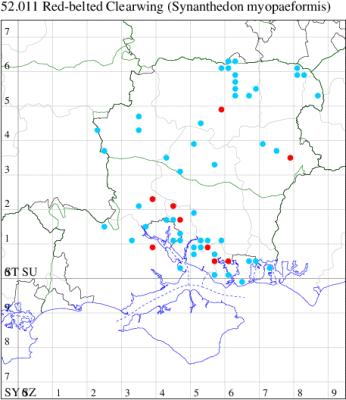
Records by year
Records by week (adult)
Records by week (larval)
Record Details
VC11: Marchwood, one, to pheromone lure, to 'Cul' lure, 05 Jun; four, to pheromone lure, all to CUL lure, 13 Jun; six, to pheromone lure, 24 Jun; four, to pheromone lure, 25 Jun (CTha); Romsey, one, to pheromone lure, came to CUL lure in afternoon, 13 Jun (NRJ); Itchen Valley CP, two, to pheromone lure, 16 Jul (CTha); Allbrook, two, to pheromone lure, cUL lure, 12 Jun (SIng); Funtley Meadow, one, to pheromone lure, cUL lure, 13 Jun (TDC); Fareham, one, to pheromone lure, 02 Jul; two, to pheromone lure, 17 Jul (ADT); Portchester, five, to pheromone lure, 16 Jun (DAS);
VC12: Basingstoke, one, to pheromone lure, to MYO lure, 1000hrs, 15 Jun; Kempshott, three, to pheromone lure, to MYO between 2pm and 3:30pm, 14 Jul; one, to pheromone lure, to MYO at 1515, 17 Jul (GAH); Whitehill, one, to pheromone lure, 10 Jun (ASto)
52.012 [B&F: 0374] Yellow-legged Clearwing Synanthedon vespiformis (Linnaeus, 1761) - Nb
Nationally scarce (Nb) in open woodland, parks and hedgerows in central southern England northwards to Yorkshire; occasionally locally common in gardens and on allotments. Probably under-recorded in Hampshire and on the Isle of Wight, where the extent of known records correlate with those areas in which the recording effort is concentrated. Wingspan 17-24 mm. Day-flying, occasionally seen in flight in woodland where oak trees have been felled. The early stages may be sought during the winter months, but synthetic pheromone lures are used to attract males nowadays, and this has led to a marked increase in records of the species in recent years. Larva feeds in the bark of Oak, Silver Birch, Downy Birch, Wych Elm and English Elm; larval workings may sometimes be found in abundance between the bark and wood of one-year-old oak stumps.
Records prior to 2021
| Vice County | #Records | #Individuals | First Record | Last Record |
|---|---|---|---|---|
| 10 | 20 | 7 | 1906 | 2017 |
| 11 | 64 | 80 | 1900 | 2020 |
| 12 | 58 | 77 | 1800 | 2020 |
2021 records
| Vice County | #Records | #Individuals | Max Quantity |
|---|---|---|---|
| 11 | 11 | 13 | 3 |
| 12 | 7 | 25 | 7 |
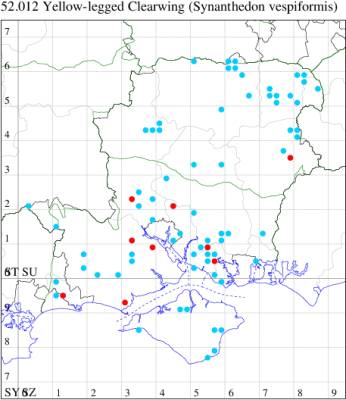
Records by year
Records by week (adult)
Records by week (larval)
Record Details
VC11: Marchwood, two, to pheromone lure, to VES lure, 20 Jun; one, to pheromone lure, 25 Jun; one, to pheromone lure, 15 Jul (CTha); Woodlands, NF*, present, field observation, 02 Sep (RBW); #N/Athree, to pheromone lure, vES, 23 Jul (JRM); Allbrook, one, to pheromone lure, vES lure 1820hrs, 15 Jun (SIng); Funtley Meadow, one, to pheromone lure, vES lure, 14 Jun (TDC); Fareham, one, to pheromone lure, 02 Jul (ADT); Christchurch, one, to pheromone lure, 09 Jun (MGibb); Great Newbridge Copse, Lymington, one, field observation, 11 Jul (MMcM);
VC12: Whitehill, four, to pheromone lure, 05 Jun; three, to pheromone lure, 25 Jun; four, to pheromone lure, 13 Jul; two, to pheromone lure, 21 Aug; four, to pheromone lure, 23 Aug; seven, to pheromone lure, 24 Aug; one, to pheromone lure, 05 Sep (ASto)
52.013 [B&F: 0373] Currant Clearwing Synanthedon tipuliformis (Clerck, 1759) - Nb
Nationally scarce (Nb) in gardens, farmland, market gardens and allotments in southern England northwards to Aberdeenshire, and north and south Wales (MBGBI Vol 2). In Hampshire and on the Isle of Wight there are clusters of records in and around Portsmouth and Gosport; in recent years, increasingly reported elsewhere in the county and on the Island. Wingspan 17-20 mm. Day-flying, the moth flying in sunshine over currant bushes Ribes. The early stages may be sought during the winter months, but synthetic pheromone lures are now used to attract males nowadays, and this has led to a marked increase in records of the species in recent years. Larva feeds within stems of Black Currant, Red Currant and Gooseberry.
Records prior to 2021
| Vice County | #Records | #Individuals | First Record | Last Record |
|---|---|---|---|---|
| 10 | 12 | 5 | 1856 | 2015 |
| 11 | 84 | 182 | 1900 | 2020 |
| 12 | 50 | 87 | 1951 | 2020 |
2021 records
| Vice County | #Records | #Individuals | Max Quantity |
|---|---|---|---|
| 10 | 1 | 1 | 1 |
| 11 | 4 | 8 | 5 |
| 12 | 1 | 1 | 1 |
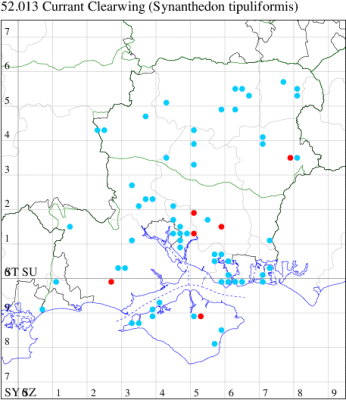
Records by year
Records by week (adult)
Records by week (larval)
Record Details
VC10: Newport, one, field observation, 31 May (SuHug);
VC11: Fair Oak, five, to pheromone lure, tIP Lure, 23 Jun (SIng); Botley, one, to pheromone lure, to TIP, 13 Jun (SLB); Swanmore, one, indoors, 20 Jun (MCha); Sway, one, indoors, 14 Jun (Unknown det. MJW);
VC12: Whitehill, one, to pheromone lure, 12 Jun (ASto)
52.014 [B&F: 0382] Six-belted Clearwing Bembecia ichneumoniformis ([Denis & Schiffermüller], 1775) - Nb
Nationally scarce (Nb) on chalk and limestone grassland, downland, embankments and quarries in southern England, south Wales and east Yorkshire. Fairly widely distributed mainly on downland across Hampshire, and mainly along the south coast in the Isle of Wight. Wingspan 15-21 mm. Unmistakable. Day-flying, sometimes found nectaring by day but most frequently encountered as a visitor to pheromone lure. Larva feeds within roots of Bird's-foot Trefoil and Kidney Vetch.
Records prior to 2021
| Vice County | #Records | #Individuals | First Record | Last Record |
|---|---|---|---|---|
| 10 | 87 | 243 | 1856 | 2020 |
| 11 | 120 | 733 | 1951 | 2020 |
| 12 | 74 | 364 | 1951 | 2020 |
2021 records
| Vice County | #Records | #Individuals | Max Quantity |
|---|---|---|---|
| 10 | 4 | 15 | 7 |
| 12 | 6 | 34 | 20 |
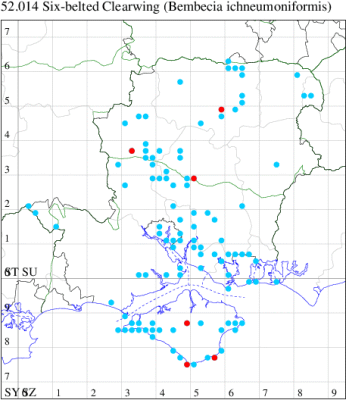
Records by year
Records by week (adult)
Records by week (larval)
Record Details
VC10: Niton, seven, to pheromone lure, 17 Jul; St Catherine's Point, five, to pheromone lure, 17 Jul (PBar); Mount Joy Cemetery, Carisbrooke, one, field observation, 13 Jul (GShe); Wheelers Bay, two, field observation, 14 Jul (ABut);
VC12: Danebury Hill Fort, two, transect, 14 Jun (MGri); Winchester, eight, to pheromone lure, 18 Aug (GSD); Old Down, Kempshott, 20, to pheromone lure, widespread and common across the down to API lure, 05 Aug; two, to pheromone lure, to API lure, 15 Aug (GAH); Old Down, Basingstoke, two, field observation, 24 Aug (ACB)
